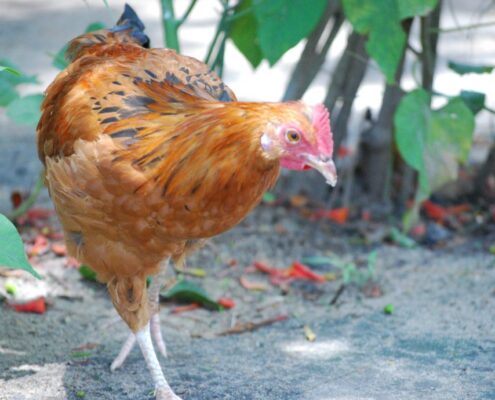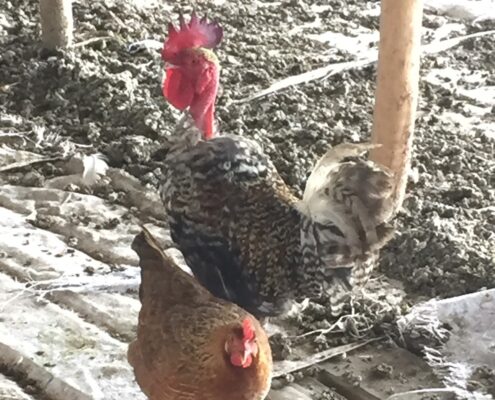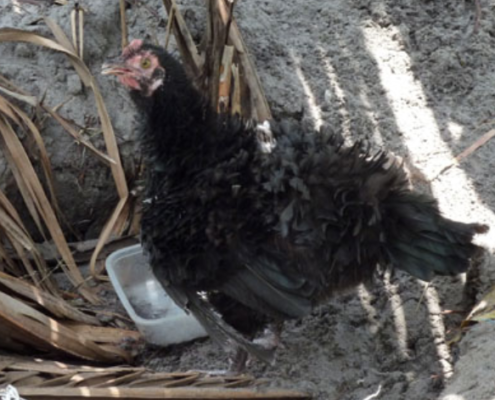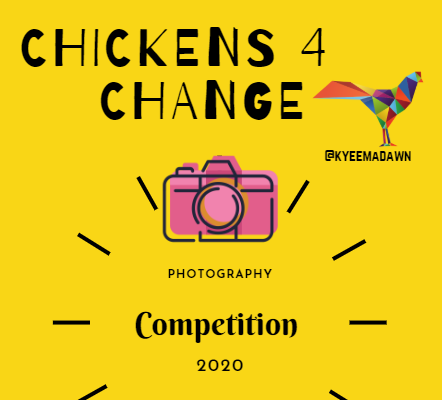What exactly are indigenous chickens?
Smaller bodies, frizzled feathers and feather-less or naked necks are traits that confer great resilience to indigenous poultry in the places we work.
Chickens have lived in rural villages throughout Africa and the Pacific for centuries and have adapted to the local environment and conditions. These village chickens are referred to as ‘indigenous’, ‘native’, ‘local’ or ‘traditional’ poultry and are easy to distinguish from standardised commercial or heritage breeds.
Selection pressures over the years have yielded traits such as hardiness in more intense weather conditions, local disease resistance, excellent feed conversion ratio (meaning they can be sustained with little feed supplementation) and are multi-purpose (eggs and meat) in a free-range system. They generally do not conform to standardised breed ‘looks’ as many backyard breeds do. However, physical traits such as light carcass weight, naked necks and frizzled feathers are common among indigenous birds, as they have adapted for heat tolerance and ability to evade predators (in the case of their small body).
They also hatch their own eggs and look after their chicks well, therefore ensuring a continuous supply of replacement stock if they are kept healthy and effort is made to protect them from predators.
Compared to commercial meat chickens, these birds are leaner with more nutrient-dense meat (and more often than not quite popular and pricier according to local taste).The hens lay a smaller number of eggs per clutch and fewer clutches per year as they need time to brood and care for their young chicks. Indigenous chicken eggs tend to be smaller than commercial eggs but the ratio of yolk to white is higher, improving the overall nutrient density of the egg. Critically, indigenous birds are great scavengers and this saves their owners time, money and reduces competition for feed such as maize that is eaten by household members.
Indigenous chickens are a valuable reservoir of diverse genes. More continues to be learned about their genetic makeup, so that the wider gene pool of these so called ‘native ecotypes’ can be conserved as a valuable global food resource for a climate smart future.
Photo credits: 1 – Pretty patterned hen in Tanzania, Louise Grayson; 2 – Naked neck rooster in Papua New Guinea, Celia Grenning; 3 – Frizzled hen in Mozambique, Rosalie Hans (Aviculture Europe – Chickens in Africa) ; 4- Rooster in Malawi, Eliza Smith; 5 – Boschveld hens in Mozambique, Rosa Costa ; Blog cover photo – Eliza Smith, Malawi.
Learning with children at home?
Join Dr Robyn Alders of Kyeema as she takes you on the Newcastle disease journey with farmers in Tanzania – Watch 5 minute video
Get involved in our #Chickens4Change photography competition
Subscribe to our e-news – see how our work supports outcomes for coral reef restoration in PNG – Watch 1.5 minute video
Print this Chickens4Change Factsheet – perhaps a learning content for a primary school report or presentation task? Recommend for Years 5-7.
Like and follow us @kyeemadawn on social media for a #chickensoftheworld educational series.









